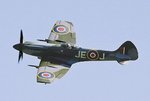
Vought F4U-4 Corsair
Engine: Pratt Whitney R-2800-18.
Power: 2,450 hp.
Max speed: 446 mph.
Max Range: 1190 miles.
Empty Weight: 4,175 kg.
Max Weight: 6,654 kg.
Service ceiling: 12,649 m.
Wing Span: 12.5 m.
Wing Area: 29.17 m2.
Armament: Six .50 cal machine guns.

Spitfire Mk.XIV.e
Engine: Rolls-Royce Griffon 65.
Power: 2,035 hp.
Max Speed: 448 mph.
Max Range: 457 miles.
Empty Weight: 2,994kg.
Max.Weight: 3,856kg.
Service ceiling: 13,560 m.
Wing Span: 11.23 m.
Wing Area: 22.48 m2.
Armament: two 20mm Hispano cannons and two .50 cal machine guns.
----------------------------------------------------------------------------------
If pilot skill is equal, then wich fighter would you bet your money on in a fight between the two ?




